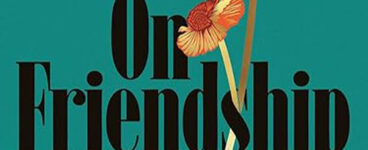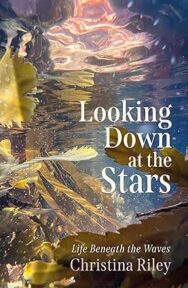‘To say, “I want you to see this” for no reason other than the belief that it will bring pleasure or joy is always worthwhile.’
In 2022, Christina Riley became an ‘underwater artist in residence’ at the Argyll Coast Hope Spot, and the essays she wrote about her time there have been collected in this wonderful book. In this extract she talks about sharing the wonder of the natural world.
Looking Down at the Stars: Life Beneath the Waves
By Christina Riley
Published by Saraband
The coast toys with the senses. Some days it is striking in its stillness and silence. On others, the wind tears away the calls of gulls and crashing waves. Around midsummer, my usually beloved seaweed made me gag as it rotted in the stagnant heat. When the tide was especially low, I could walk far out onto the intertidal rock pools and feel the barnacles jag into the soles of my feet or, while kneeling to stare at a hermit crab, deep into my knees. The pain rose almost imperceptibly until suddenly it was searing, but the crab was surely about to move again … so, just bear it a little bit longer. Back on the sand, some pebbles were so sea polished they gleamed like glass, calling out to be rolled around in the palm. Like the tiny patch of tiny shells, there was a particular spot to find, and sit amongst, these perfectly polished pebbles (how they were all carried to the same area is a mystery to me). Handling the cool stone on a hot day, the beach came to inhabit more of my body, increasing my physical sensitivity to a shifting landscape which always, with every visit, without fail, provided something new to feel. To sit down, staring at the sea, holding something like comfort in the palm of my hand, felt like a valuable way to spend my time. These days spent feeling the beach acutely made it appear all the fuller to my heightened senses and quietening mind. Each day added a layer that compressed and solidified my love for this coast and for others. It matters how we experience the coast. It matters what we take away from it in our minds, in our hands and in our pockets. It matters that we tread lightly but feel fully.
Emptying my pockets at home, I’d shuffle them around on the floor in some kind of flat lay and, inevitably, a pattern would form in the swirling symmetries or the tilting of a whelk, or a periwinkle would spill light into its concave. Empty shells, stilled lives. Gathered, they seemed to spell out whatever it was I didn’t have the energy or clarity to say with words. The all-encompassing sea begs for a physical, three-dimensional experience, something I had the privilege of feeling every single day. Yet some of the most intimate moments of this beach diary occurred on social media. Each night, I posted a photograph of the day’s arrangement to Twitter, for no particular reason other than it was the most accessible and simplest way of sharing them, which I suppose I felt a desire to do. But I worried that the speed of social media would somehow wash the beauty away from such tactile artefacts, trivialising an intimate moment by squeezing it into a chaotic and two-dimensional one. The tenacity of Twitter didn’t feel in sync with my experience on the shore. These objects lured me in by the way they caught the light, by their curved surfaces or the way the colours shifted as they turned in my hand. Twitter didn’t feel like a place to express love, be it for a person or a place. But in those early days of lockdown, Twitter became an intensely sensitised realm. Our emotions had nowhere else to go. And as it turned out, I gained as much joy, beauty and—perhaps most importantly in spring 2020—connection online as I did by the sea.
Eventually, these daily tweets formed a book, The Beach Today. A scrapbook of sorts, or a diary, attempting to tell the story of the coast at a time when words failed. How could I describe every contour of a shell, or the soft chalk that transfers onto my salt-dried and cracked skin when rolled between my fingertips? The photograph acted as the memory, or souvenir. The means of saying, “Wow, would you look at this?”
This makes me think about who gets to tell what story, and how words fail me when the subject is of the underwater realm. It isn’t for me to say how a whelk, or the kelp, lives their life, or how they feel. If we write what we know, then there’s nothing I can contribute when it comes to the unknowable sea. It’s a lesson in what needs to be said and what’s best left unsaid, and in imparting stories onto a place that isn’t my domain. Anything I write about the sea can only come from the perspective of land, and never will I be able to write truthfully about the way an octopus understands coralline algae enough to camouflage itself against its purple encrustations, despite being unable to see colour itself. Or perhaps they can, I may never know. How could I ever write about an octopus other than to tell you how it makes me feel to live on earth at the same time as that octopus? To tell you that the octopus, that all of it, is miraculous?
It’s important to love what we don’t understand.
We thought we understood whales enough to execute horrors onto them. We thought fish were inexhaustible. One of the (many) difficulties of the pandemic has been grasping the idea of doing nothing as a means of doing something. What’s the difference between walking a mile on a beach, or taking that same time to sit down on it? Not moving an inch but exploring each shell within your arm’s reach? What would be gained by doing less? Would it, in fact, be more? What is “less” and “more,” anyway?
In More About Wild Nature, Eliza Brightwen sums up at least one reason why we attempt to share a place, whether it’s through language, photographs, or collecting objects, contemplating this innate desire we have to show others the beauty we’ve witnessed ourselves. She explains that even if the task of describing a sunset to one who hasn’t seen it appears feeble, it’s worth trying nonetheless:
“The friend will be able to conjure up from your description not perhaps the sunset you saw, but something bright and beautiful that will bring refreshment to a mind possibly very wearied with the monotony of everyday life. Sweeter still will be to her the thought that, whilst nature was giving you such exquisite pleasure, you received only that you might bestow, you took thought and pains that she might be the sharer of your joy.”
To say, “I want you to see this” for no reason other than the belief that it will bring pleasure or joy is always worthwhile. By photographing these beach collections and posting those photos online, inanimate objects gave rise to human connection, a shared looking at the sea. An encrusted clam shell its own seascape, something to point to and say, ‘What do you think of this?’ There is no right or wrong answer. There is also a commitment made when you choose a place (or perhaps it chooses you) and share it with others. To look at a beach with slow and meticulous wonder is to see it for everything that it is: tangled weed and wires, periwinkles and plastic, sea and smashed glass. Not all of our seaside experiences are pleasurable, and the more we get to know a place, the more we understand that it is often as much a story of loss as of abundance. But it is in the face of loss we need to be looking, collecting, and sharing that which we love, that which we don’t want to lose.
Looking Down at the Stars: Life Beneath the Waves by Christina Riley is published by Saraband, priced £12.99.
ALSO IN THIS ISSUE

 Brutal Scotland by Simon Phipps
Brutal Scotland by Simon Phipps
‘As I travelled, I wasn’t only drawn to buildings. I began documenting public art – those often abst …

 David Robinson Reviews: On Friendship by Andrew O’ Hagan
David Robinson Reviews: On Friendship by Andrew O’ Hagan
‘In eight elegant essays, O’Hagan expands his thoughts on friendship to include lost friends, pets, …













